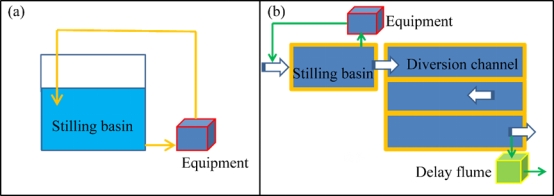Yinlei Yao , Kang He , Yuying Li *, Xia Zhang ,*, Zhaolong Ma, Zhenzhen Cui , Wenjun Zheng, Beata Messyasz and Xiaonuo Chen. Research and Application of Supersaturated Dissolved Oxygen Technology Combined with Magnetization Technology in the Improvement of Water Quality: Taking the South-to-North Water Diversion Project of China as a Pilot Project. Sustainability 2022, 14, 2684. https://doi.org/10.3390/su14052684
第一作者:Yinlei Yao
通讯作者:Yuying Li
背景介绍:细分子超饱和溶氧-超强磁化技术是将超饱和溶氧技术与水体磁化技术相结合的一种复合技术。相对于传统的水体净化技术,这种技术的优点包括在不投加任何药剂,无需清除淤泥和不改变河道的原有功能的情况下明显、高效的提升河道水质。本研究中,以南水北调中线干渠为研究背景,评估了SDOXUM复合工艺对中线干渠水体微生物活性,浮游植物群落结构和主要营养指标的去除效果的影响。
试验运行方案:分别针对静态水体和流动水体,将本研究分为静态实验和动态实验两个部分通过检测有机物的去除,ATP的相对光单位和浮游植物群落结构的变化以及人工水草作为生物膜的载体对有机物去除效果及微生物活性的影响,来评估SDOXUM系统的性能。
静态实验通过虹吸管将中线干渠的水体引入消力池,使消力池中的存水容积为3400 m3,随后关闭虹吸管截止阀(cut-off valve),利用净水设备对水体进行处理.本项试验设置处理次数分别为1次、2次和3次(设备运行时间分别为8.5 h、17 h和25 h).分别考察处理后的水体在静置24 h、48 h和72 h的水质变化.每次开始下次处理实验前,排空上次的水体并重新从干渠引水.测量引入的水体电导值保证其与干渠水体电导率一致.
动态实验通过虹吸管从中线干渠连续引水,海漫段和延时水槽连续出水。从消力池出水口处抽取水体,经设备处理后通过布水管在虹吸管出水处与干渠水体混合.混合水体经海漫段的导水槽排入白河。控制水泵流量在海漫段出水口处抽取部分水体使其在延时水槽中停留后流出.动态实验设置的流速分别为0.025 m/s、0.045 m/s和0.104 m/s(处理量与引水量的比值分别为1:1、1:2和1:5).动态实验分为有人工水草组和无人工水草组,考查各组在不同流速条件下,水体分别经设备处理混合12 h、24 h和48 h的水质提升效果.

设备运行方案
结论;SDOXUM技术将过饱和溶解氧技术与水磁化技术相结合,可有效提高水中DO浓度。SDOXUM技术不仅可以提高水中的氧传递速率和氧传递效率,而且可以长时间(3天以上)维持DO浓度的过饱和状态。
SDOXUM技术能有效去除水体中的主要营养指标(NH3-N、NO3--N、CODMn、TN、TP),通过为水体创造超好氧环境,提高自然水生态系统的净化能力,增强微生物活性,改善浮游植物群落结构。
人工水生植物的引入对DO浓度没有影响。在研究过程中,虽然DO浓度不受人工水生植物的影响,但人工水生植物的作用提高了主要检测指标的去除率。
SDOX技术是一种很有前途的水体净化技术。静态实验为应用SDOXMUM技术改善静态水体(南水北调节约工程、湖泊、水库)水质提供数据参考和技术支撑,动态实验为应用SDOXMUM技术改善流动水体(南水北调主干道、天然流域和城市河流)水质提供重要技术支撑。
Research and Application of Supersaturated Dissolved Oxygen Technology Combined with Magnetization Technology in the Improvement of Water Quality: Taking the South-to-North Water Diversion Project of China as a Pilot Project
Abstract: Supersaturated dissolved oxygen and magnetization (SDOXM) technology is a composite technology that combines supersaturated dissolved oxygen with water magnetization technologies. Compared with conventional water purifification technology, the advantages introduced by such technology include obvious and effificient improvement in purifified water quality without adding any chemicals, removing sludge and changing the original function of the river. In this study, taking the Middle-Route (MR) of the South-to-North Water Diversion Project of China (SNWDPC) as a pilot project, the effects of the SDOXM composite process on microbial activity, phytoplankton community structure, and removal effificiency of the main nutritional indexes in the canal of the MR were evaluated. Aiming at static and flflowing water bodies, this study was divided into two parts: static and dynamic experiments (two groups: a group with artifificial aquatic plants and another group without artifificial aquatic plants). The performance of the SDOXM system was assessed by monitoring the organic matter removal as well as the relative light unit (RLU) of ATP, changes in the community structure of phytoplankton, and the effects of artifificial aquatic plants as a biofifilm carrier on organic matter removal and microbial activity. During the study period, SDOXM technology was able to increase the concentration of dissolved oxygen (DO) in water and maintained the state of supersaturation for more than three days. The removal effect of organic matter from water was obvious. The community structure of phytoplankton changed from the Bacillariophyta-Cyanophyta type to the Bacillariophyta-Cyanobacteria type. Finally, the introduction of artifificial aquatic plants has contributed to the improvement in water quality. Therefore, SDOXM technology can be used as a new water quality improvement technology to enhance the self-restoration ability of a river natural ecology.
Keywords: supersaturated dissolved oxygen; magnetization; water quality improvement; technology; phytoplankton; microbial activity; organic matter removal